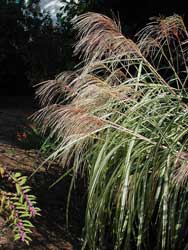Resource Library
Plant of the Week: Maiden Grass
The University of Arkansas System Division of Agriculture does not promote, support or recommend plants featured in "Plant of the Week." Please consult your local Extension office for plants suitable for your region.
Plant of the Week
Maiden Grass
Latin: (Miscanthus sinensis)

The look of our landscapes is constantly changing. Not only do they change from season to season, but also change over time as plants come and go as the whims of fashion mysteriously dictate. Ornamental grasses, important garden plants during the height of the Victorian era, have reappeared to become a mainstay for contemporary landscape plantings.
The most common and widely adapted of the ornamental grasses are the various maiden grasses (Miscanthus sinensis) from China. These tough, clump-forming grasses have slender, half-inch wide leaves that gracefully arch from the ground. In the fall they send up silvery or brownish feathery tassels that fade to tan as fall turns to winter.
They are very easy to grow and expand every year. I planted 'Gracillimus' a decade ago and it is now about three feet wide at the base and six feet tall when it flowers in late September. To many the paper-bag brown wintertime color of maiden grasses is as appealing as its summertime appearance.
The height of the plant depends on the type of Miscanthus you select. There are now more than 40 cultivars of maiden grass in the nursery trade, so make sure you know the characteristics of the one you choose. 'Nippon' is a dwarf form with foliage 2 to 3 feet tall with the flowers topping out at 4 feet. 'Giganteus' (also called M. floridulis) produces stems that grow straight as an arrow and reaches 10 feet.
But, perhaps the most popular of the maiden grasses are the variegated types. My favorite of these is a thin-leafed, four-foot tall, delicate form called 'Morning Light.' It has a thin white strip on the leaf margin that is easy to miss because the leaf itself is so narrow. Plant this where it can be backlit by the morning sun for a remarkable effect.
Two other variegated forms, 'Cabaret' with its wide white stripe down the length of the blade and the unusual 'Zebrina' with yellow variegation running across the leaf blade, are worth having if you have room. These plants tend to be a bit floppy and graceless in flower, but their foliage effect is grand. 'Little Zebra' is a 4-foot tall selection that is more compact and less floppy than the older 'Zebrina.'
All of these grasses need at least six hours of sunlight. They are not picky about soil, but will grow larger and faster in good soil than poor. Once established, they are extremely drought tolerant. They are essentially immune to disease and insect problems.
Ornamental grasses are ideal for screening, for use as specimen plants or as substitutes for conventional shrubs. They also make stately specimens when used in large containers but in cold areas the pots will need to be sunken during winter to protect the roots from freezing.
The hardiest forms of Maiden Grass will grow from USDA zones 4 through 9. Taller growing types and broad-leafed clones are usually somewhat less hardy, usually going only as far north as zone 5. The cane-forming Miscanthus floridulis is only hardy to zone 6.
In late winter, before the seeds begin to be released, cut the plants to the ground and haul the stubble off to the compost pile. In some areas Maiden Grass has escaped cultivation. This can be avoided by cutting away plumes before seeds are released or selecting late flowering clones that bloom in October and will not have time to mature seeds before the first frost.
Should you want to propagate your plants, divide them in the spring. A small division can be cut off of the edge of a large clump by digging a crescent shaped trench on one side and then splitting the clump by means of an ax. Finesse and a gentle touch is not needed - only brute force.
By: Gerald Klingaman, retired
Extension Horticulturist - Ornamentals
Extension News - October 24, 2008
The University of Arkansas System Division of Agriculture does not maintain lists of retail outlets where these plants can be purchased. Please check your local nursery or other retail outlets to ask about the availability of these plants for your growing area.